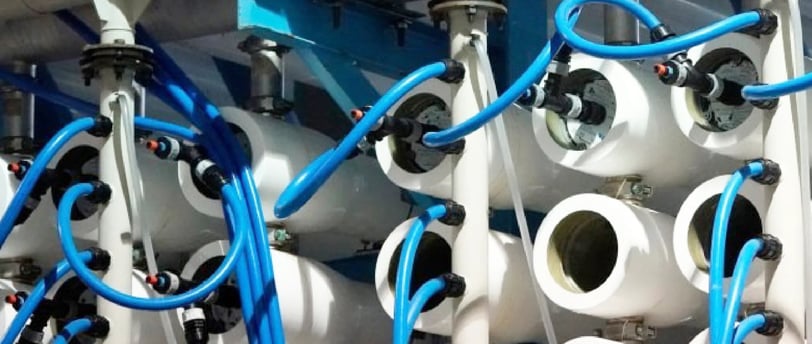Designing Mid-Sized Desalination Plants for Water Security in a Small Coastal City
Water security is a growing concern for small, remote coastal cities, where freshwater resources are often scarce or vulnerable to climate change. For a city of approximately 15,000 people, a mid-sized desalination plant offers a sustainable solution to ensure a reliable, high-quality water supply. This blog post explores the key considerations, technologies, and steps involved in designing an efficient desalination plant tailored to the needs of such a community.
WATER PURIFICATIONENVIRONMENTAL TECH
6/3/20254 min read


Small coastal cities often face unique challenges: limited groundwater, seasonal rainfall, and dependence on distant water sources. Desalination, the process of removing salt and impurities from seawater, provides a drought-resistant, consistent water supply. For a city of 15,000, a mid-sized desalination plant can meet daily water demands while balancing cost, energy efficiency, and environmental impact.
Based on typical per capita water use (approximately 100–150 liters per person per day), a city of 15,000 requires about 1.5–2.25 million liters per day (MLD), or roughly 400,000–600,000 gallons. A mid-sized desalination plant producing 2–3 MLD can comfortably meet this demand, including residential, commercial, and industrial needs, with room for growth.
Key Design Considerations
Designing a desalination plant for a small coastal city involves balancing technical, economic, and environmental factors. Here’s a breakdown of the critical elements:
1. Capacity and Scalability
Target Output: A plant producing 2–3 MLD is ideal for a population of 15,000. This accounts for peak demand and provides a buffer for maintenance or future population growth.
Modular Design: Opt for a modular system that allows for easy expansion. Modular units reduce upfront costs and enable the plant to scale as demand grows.
2. Technology Selection
The two primary desalination technologies are Reverse Osmosis (RO) and Multi-Stage Flash (MSF) distillation. For a mid-sized plant, RO is typically preferred due to its lower energy consumption and smaller footprint.
Reverse Osmosis (RO): RO uses high-pressure membranes to filter salt and impurities from seawater. Modern RO systems are energy-efficient, with advancements like energy recovery devices (e.g., pressure exchangers) reducing energy use to 2.5–3.5 kWh per cubic meter of water produced.
Pre-Treatment: Seawater often contains sediments, algae, and organic matter. Robust pre-treatment systems (e.g., ultrafiltration or dissolved air flotation) are essential to protect RO membranes and ensure longevity.
Post-Treatment: After desalination, water needs remineralization (adding calcium and magnesium) to meet drinking water standards and prevent corrosion in distribution systems.
3. Energy Efficiency
Energy is the largest operational cost in desalination, so efficiency is critical.
Renewable Energy Integration: Pair the plant with solar or wind power, abundant in many coastal regions, to reduce reliance on fossil fuels. For example, a 2 MLD RO plant requires about 6,000–8,000 kWh daily, which could be partially offset by a small solar array.
Energy Recovery Systems: Devices like pressure exchangers can recover up to 60% of the energy used in the RO process, lowering costs and environmental impact.
4. Environmental Impact
Desalination plants must minimize harm to marine ecosystems and local environments.
Brine Management: Desalination produces concentrated brine as a byproduct. Disperse brine using diffusers to minimize harm to marine life, or explore options like brine reuse for salt production or aquaculture.
Intake Systems: Use subsurface or beach well intakes to reduce the impact on marine organisms compared to open-ocean intakes.
Carbon Footprint: Integrating renewables and energy-efficient technologies helps mitigate the plant’s carbon emissions.
5. Site Selection
Proximity to Coast: Locate the plant near the shoreline to minimize pipeline costs but ensure it’s elevated or protected against storm surges and sea-level rise.
Access to Infrastructure: Choose a site with access to power grids and water distribution networks to reduce construction costs.
Environmental Sensitivity: Avoid ecologically sensitive areas, such as coral reefs or mangroves, to minimize disruption.
6. Cost Considerations
Capital Costs: A 2–3 MLD RO plant typically costs $10–20 million to build, depending on location, technology, and infrastructure needs.
Operating Costs: Energy, labor, and membrane maintenance drive operational costs, typically $0.50–$1.50 per cubic meter of water produced.
Funding Options: Seek public-private partnerships, government grants, or international funding (e.g., from development banks) to offset costs for small communities.
Steps to Design and Implement
Feasibility Study:
Assess local water demand, existing supply, and growth projections.
Evaluate seawater quality and environmental conditions.
Conduct a cost-benefit analysis comparing desalination to other water sources (e.g., groundwater or imports).
Engineering Design:
Select RO technology with energy recovery and robust pre-treatment.
Design modular systems for scalability and maintenance ease.
Plan brine disposal and intake systems to meet environmental regulations.
Permitting and Stakeholder Engagement:
Obtain environmental permits and ensure compliance with local regulations.
Engage the community through public consultations to address concerns about costs or environmental impacts.
Construction and Commissioning:
Build in phases to manage costs and test systems incrementally.
Train local staff to operate and maintain the plant.
Operation and Maintenance:
Implement regular membrane cleaning and replacement schedules.
Monitor water quality and environmental impacts continuously.
Optimize energy use through real-time data and automation.
Case Study: A Model for Success
The town of Lamberts Bay, South Africa (population ~6,000), implemented a 1.7 MLD RO desalination plant in 2019 to address drought-induced water shortages. Powered partly by solar energy, the plant supplies reliable water while minimizing costs. Scaling this model to 2–3 MLD for a city of 15,000 could involve similar strategies, such as renewable energy integration and community-driven planning, to ensure affordability and sustainability.
Challenges and Solutions
For a small coastal city of 15,000, a mid-sized desalination plant offers a lifeline to water security. By leveraging energy-efficient RO technology, renewable energy, and environmentally responsible design, such a plant can provide clean, reliable water for decades. With careful planning and community support, desalination can transform a vulnerable city into a resilient one, ready to face the challenges of a changing climate.
